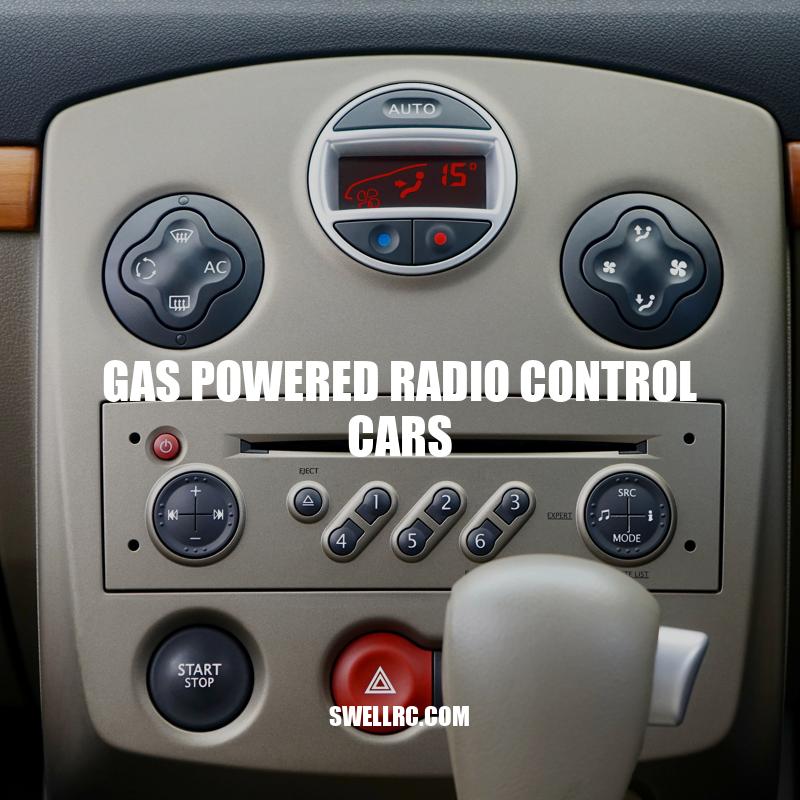Gas Powered RC Cars: Pros, Cons and Maintenance
Gas-powered radio control cars are a popular option for hobbyists and enthusiasts who love speed, power, and control. These cars run using nitro-methane fuel and offer an alternative to electric-powered RC cars. Gas-powered RC cars are known for their incredible speed and power, making them an excellent choice for people who are into racing and stunts. The engines used in these cars are often more powerful than electric engines, and they produce a distinct sound that adds to the excitement of using them. Gas-powered RC cars come in various sizes and types to suit the user’s skills and preferences. Additionally, these cars are highly customizable, allowing hobbyists to modify and upgrade the cars to achieve better performance. However, like any other machine, gas-powered RC cars come with their disadvantages, such as high noise levels and maintenance needs. In this article, we will take a detailed look at gas-powered radio control cars, discussing their working mechanism, pros and cons, maintenance, upgrading, and choosing the right vehicle.
Gas-powered radio control cars work using a nitro-methane fuel system, which is different from electric-powered RC cars. Unlike electric motors, gas-powered engines run on a combustion process that converts fuel into energy. Therefore, these engines require more complicated internal parts and functions to provide the power and speed that hobbyists love. The following are the essential elements of gas-powered radio control cars:
- Engine: the heart of the car that generates power using a combustion process fueled by nitro-methane. Engines come in different types and sizes depending on the vehicle’s intended use.
- Fuel Tank: the container that holds the nitro-methane fuel used to power the engine.
- Transmission System: the gears, clutch, and flywheel that transform the engine’s rotational energy into forward or backward motion.
- Exhaust System: responsible for the disposal of gases produced by the combustion process to the atmosphere.
- Receiver and Servos: The receiver allows for remote control of the car, and servos are responsible for controlling the throttle, steering, and brakes.
Some of the popular gas-powered radio control car brands available in the market include Redcat Racing, Traxxas, and HPI Racing, among others. These brands produce a variety of car types and sizes suitable for different skill levels and purposes, including buggies, monster trucks, and off-road cars. Additionally, several websites specialize in providing resources, accessories, and parts for gas-powered RC cars, such as NitroRCX and RCPlanet.
Can you run a nitro RC car on gas?
No, you can’t run a nitro RC car on gas because nitro engines don’t have a spark plug. However, there are model engines that are specifically designed to run on gasoline, but they’re typically larger. More information on RC cars can be found on websites such as RC Planet and Horizon Hobby.
Gas-powered radio control cars have their advantages and disadvantages compared to electric-powered RC cars. Here are some of the pros and cons of gas-powered radio control cars:
Pros:
- Power: Gas-powered engines produce more power and speed than electric motors, making them ideal for outdoor racing and challenging terrains.
- No Charging: Unlike electric motors, gas-powered engines do not require charging and have longer running times before refueling.
- Realistic Sound: Gas-powered engines produce a roar similar to real cars, providing a real driving experience.
- Customization: Gas-powered radio control cars are customizable, allowing owners to change parts and adjust the engine’s settings for better performance.
Cons:
- Noise: Gas-powered engines are louder than electric motors, making them unsuitable for indoor racing and quiet neighborhoods.
- Maintenance: Gas-powered engines need proper maintenance, including oiling, cleaning, and part inspections, to function well and last longer.
- Cost: Gas-powered radio control cars are more expensive than electric ones, and the cost of nitro-methane fuel and spare parts adds up over time.
- Pollution: Gas-powered engines produce emissions that contribute to air pollution, making them unfavorable for the environment.
Gas Powered vs. Electric Powered Radio Control Cars
| Feature | Gas Powered | Electric Powered |
|---|---|---|
| Speed and Power | Produces more power and speed | Produces less power and speed |
| Charging | No charging, longer run time before refueling | Requires charging |
| Noise | Produces more noise | Produces less noise |
| Customization | Highly customizable | Less customizable |
| Maintenance | Requires more maintenance | Requires less maintenance |
| Cost | More expensive | Less expensive |
| Pollution | Produces emissions | Zero emissions |
Despite their cons, gas-powered radio control cars remain popular among hobbyists and enthusiasts who value the power, speed, and realism of these vehicles.
Are gas or electric RC cars better?
Electric RC cars are generally faster than gas RC cars due to the efficiency of their brushless motors and LiPo batteries. In fact, some electric RC cars can reach speeds over 100 mph. However, gas or nitro RC cars can provide a more authentic driving experience. If you want to learn more about RC cars, you can check out websites like Traxxas or Horizon Hobby, which offer a variety of electric and gas RC cars for all levels of experience.
Tuning and Upgrading Your Gas Powered Radio Control Car
One of the most exciting aspects of owning a gas-powered radio control car is tweaking and customizing it to enhance its performance. Here are some tuning and upgrading options that you can consider for your gas-powered RC car:
- Upgrade the Exhaust System: Installing a high-quality exhaust system can offer better performance, throttle response, and fuel efficiency.
- Change the Engine Fuel Mixture: Adjusting the fuel-to-air ratio can optimize the engine’s performance and power output.
- Swap the Glow Plug: A new or upgraded glow plug can increase the engine’s ignition power and start-up speed.
- Upgrade the Air Filter and Air Intake: A high-performance air filter and intake can improve the flow of air to the engine, enhancing fuel combustion and power production.
- Adjust Tire Pressure: Optimal tire pressure can increase traction, acceleration, and speed.
- Install a New Clutch: A high-performance clutch can offer better acceleration, speed, and control over the car’s power delivery.
When tuning and upgrading your gas-powered radio control car, it’s essential to have the right tools and equipment, such as a wrench, screwdriver, pliers, and a tuning kit. You can find various resources online, including video tutorials and guides, to help you with the tuning process.
Some online platforms, such as Horizon Hobby, R/C Planet, and NitroRCX, offer a wide range of gas-powered radio control cars and parts to cater to the needs of radio control enthusiasts. Their websites provide detailed descriptions and ratings of products to help you make an informed purchase decision.
If you’re new to gas-powered radio control cars, it’s crucial to understand the basics before attempting tuning or upgrading your car. You can consult with experienced hobbyists, join online forums or local clubs to learn from others in the hobby.
How can I make my remote control car more powerful?
If you want to make your remote control car more powerful, try changing the pinion gear or the spur gear. A larger pinion gear will provide more speed, while a smaller one will provide more torque and acceleration. A smaller spur gear will also increase torque and acceleration, but decrease top speed. You can change one or both gears to achieve the desired effect. You can visit websites like HobbyKing or Tower Hobbies to find replacement gears that fit your car model.
Gas powered radio control cars require proper maintenance to ensure their longevity and optimal performance. To achieve this, here are some essential tips to keep in mind:
- Clean the Car Regularly: After each use, use compressed air to blow off the dirt and debris from your car. Use a soft-bristle brush or cloth to remove any remaining dirt from the chassis, suspension, tires, and other parts of the car.
- Lubricate the Car: Apply light lubrication to the servo gears, drive shaft, and other moving parts of the car after cleaning it.
- Inspect the Car: Regularly check the car’s parts, including fuel lines and filters, airboxes, and driveshafts, for any signs of wear and tear. Replace any worn-out or damaged parts immediately.
- Store the Car Properly: When not in use, store your car in a dry and cool place to prevent rust and corrosion. Remove the batteries from the car and store them separately.
- Use Quality Fuel: Always use high-quality fuel for your car and avoid using old or contaminated fuel. This can affect your car’s engine performance and damage its internal parts.
- Seek Professional Help: If you encounter any technical problems, it’s best to seek help from a professional mechanic or hobby store to avoid damaging your car.
Gas-powered radio control cars require specific maintenance tools and products, and you can find various options online or in hobby stores. For instance, you can use Traxxas, Team Losi Racing, and HPI Racing air filters, glow plugs, and fuel filters to maintain the car’s optimal performance.
Several websites provide useful information and guidelines on maintaining gas-powered radio control cars, including RCsource.com, RC Driver, and Big Squid RC. These sites offer detailed guides and video tutorials on maintenance practices, including troubleshooting and repair tips.
How do you maintain a nitro RC car?
To maintain a nitro RC car, there are a few essential steps to follow. Firstly, after each use, perform an after-run procedure on the engine. Secondly, clean the chassis and suspension to remove any dirt, grime or exhaust residue. Always remove all fuel from the fuel lines and tank once the car is not going to be used for a while. Lastly, remove the batteries from the receiver box and transmitter to prevent any damage from leaks or corrosion.
In case you need any additional information or find it challenging to perform these steps, you can visit a local hobby store or RC car service center. Websites such as AMain Hobbies or Horizon Hobby also offer a wide range of helpful products and advice on maintaining RC cars.
Choosing the Right Gas Powered Radio Control Car
Choosing the right gas-powered radio control car can be overwhelming, considering the wide variety of options available on the market. Here are some essential factors to consider when selecting the right car for you:
- Type of Terrain: Consider the type of surface on which you will use your car, such as pavement, dirt, or gravel. There are different types of gas-powered RC cars suitable for different terrains, so choose a car that is designed for the terrain you plan to explore.
- Speed: Gas-powered RC cars can reach high speeds of up to 70 miles per hour. Consider your skill level and experience when choosing the speed of your car. High-speed racing cars are suitable for experienced hobbyists, while slower cars are ideal for beginners.
- Size: Consider the size of the car you want. Gas-powered RC cars come in various sizes, from 1/16 scale to 1/5 scale. A larger-scale car might be more expensive but can offer better performance than a smaller one.
- Budget: Set a budget for your car and stick to it. Gas-powered RC cars vary significantly in price, so choose one that meets your needs and budget.
- Type of Car: Choose the type of car that interests you, such as a buggy, truck, monster or on-road car. Each type has its unique features and advantages, so choose a suitable type for you.
- Brand and Quality: Research the different brands available, and choose a reputable manufacturer that makes high-quality cars. Go for a brand that provides spare parts and accessories for easy repairs and upgrades.
Online stores such as Amazon, eBay, and HobbyTron offer a wide range of gas-powered radio control cars from different manufacturers, including Traxxas, Losi, and HPI Racing. Check out customers’ reviews and ratings to determine the car’s performance, durability, and customer satisfaction.
You can also find useful information on how to choose the perfect gas-powered RC car such as buying guides, reviews, comparisons, and video demonstrations on reputable websites such as RC Car Action, RC Driver, and RC Car Tips. These websites offer helpful information on the features, specifications, and pros and cons of different gas-powered RC cars types so that you can make an informed decision.
Which RC cars are better gas or electric?
Electric RC cars are generally better than gas powered RC cars for a few reasons. Firstly, they are typically more durable with fewer parts to replace or clean. This makes them easier to maintain in the long run. Additionally, electric RC cars are faster and longer lasting than their gas counterparts. Overall, an electric RC car would likely be a good match for your husband’s needs. Source: Wikipedia (https://en.wikipedia.org/wiki/Radio_control)
Conclusion
Gas-powered radio control cars are a fascinating hobby that can provide hours of fun and entertainment. These cars offer high speeds, power, and control that many hobbyists find intriguing. In this article, we have discussed how gas-powered RC cars work, their pros and cons, how to tune and upgrade them, choosing and maintaining them. We have also highlighted the essential factors to consider when choosing the perfect car for your needs.
Whether you are an experienced hobbyist or a beginner, a gas-powered RC car can provide an exciting experience that you won’t forget. They offer a unique thrill that you cannot find with other types of remote-controlled cars. With proper maintenance and care, a gas-powered RC car can be a durable and long-lasting investment.
If you are interested in buying gas-powered RC cars, there are many online stores and websites where you can get all the information you need. Make sure you do thorough research before making any purchases. Additionally, seek advice from other hobbyists, and join online forums to get answers to any questions you might have. With patience, dedication, and a little bit of investment, you can enjoy the thrill of driving a gas-powered radio control car for years to come.



